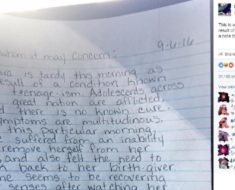
In efforts to show the interaction between period and pendulum length, Jeff Goodman (professor at Appalachian State University) made a seriously cool experiment for students.
Using a large-scale demonstration, Goodman chose 16 bowling balls as the medium of choice. The balls, lined evenly apart, arranged in a perfectly straight line were hung with even wires on a wooden frame.
When dropped at the same time, the bowling balls began shifting in an incredible and almost artful fashion. The result is a stunning display of the “art of physics.”
Here is what Goodman had to say about the experiment:
“** What am I seeing? How does this work? **
The length of time it takes a ball to swing back and forth one time to return to its starting position is dependent on the length of the pendulum, not the mass of the ball. A longer pendulum will take longer to complete one cycle than a shorter pendulum. The lengths of the pendula in this demonstration are all different and were calculated so that in about 2:40, the balls all return to the same position at the same time – in that 2:40, the longest pendulum (in front) will oscillate (or go back and forth) 50 times, the next will oscillate 51 times, and on to the last of the 16 pendula which will oscillate 65 times. Try counting how many times the ball in front swings back and forth in the time it takes the balls to line up again, and then count how many times the ball in back swings back and forth in the same time (though it’s much harder to keep your eye on the ball in back!)”
Check it out…it’s quite mesmerizing that’s for sure!
Like ✪ Share ✪ Be Awesome










































